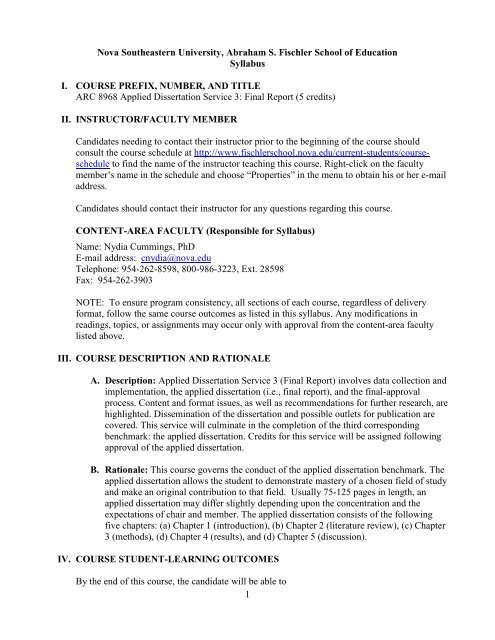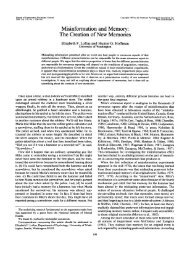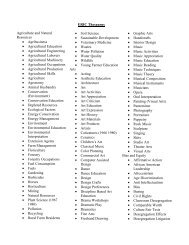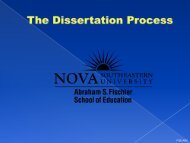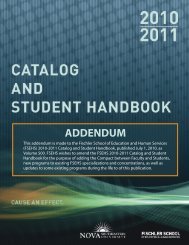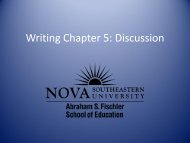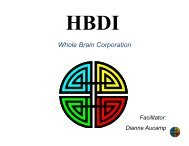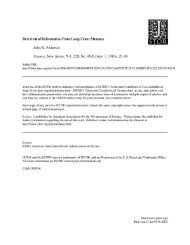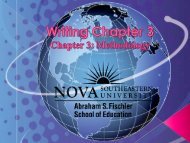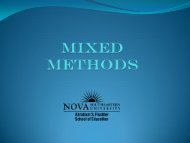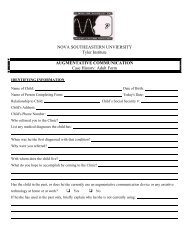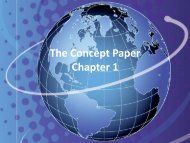ARC 8968 - 1 - Nova Southeastern University
ARC 8968 - 1 - Nova Southeastern University
ARC 8968 - 1 - Nova Southeastern University
You also want an ePaper? Increase the reach of your titles
YUMPU automatically turns print PDFs into web optimized ePapers that Google loves.
<strong>Nova</strong> <strong>Southeastern</strong> <strong>University</strong>, Abraham S. Fischler School of Education<br />
Syllabus<br />
I. COURSE PREFIX, NUMBER, AND TITLE<br />
<strong>ARC</strong> <strong>8968</strong> Applied Dissertation Service 3: Final Report (5 credits)<br />
II. INSTRUCTOR/FACULTY MEMBER<br />
Candidates needing to contact their instructor prior to the beginning of the course should<br />
consult the course schedule at http://www.fischlerschool.nova.edu/current-students/courseschedule<br />
to find the name of the instructor teaching this course. Right-click on the faculty<br />
member’s name in the schedule and choose “Properties” in the menu to obtain his or her e-mail<br />
address.<br />
Candidates should contact their instructor for any questions regarding this course.<br />
CONTENT-AREA FACULTY (Responsible for Syllabus)<br />
Name: Nydia Cummings, PhD<br />
E-mail address: cnydia@nova.edu<br />
Telephone: 954-262-8598, 800-986-3223, Ext. 28598<br />
Fax: 954-262-3903<br />
NOTE: To ensure program consistency, all sections of each course, regardless of delivery<br />
format, follow the same course outcomes as listed in this syllabus. Any modifications in<br />
readings, topics, or assignments may occur only with approval from the content-area faculty<br />
listed above.<br />
III. COURSE DESCRIPTION AND RATIONALE<br />
A. Description: Applied Dissertation Service 3 (Final Report) involves data collection and<br />
implementation, the applied dissertation (i.e., final report), and the final-approval<br />
process. Content and format issues, as well as recommendations for further research, are<br />
highlighted. Dissemination of the dissertation and possible outlets for publication are<br />
covered. This service will culminate in the completion of the third corresponding<br />
benchmark: the applied dissertation. Credits for this service will be assigned following<br />
approval of the applied dissertation.<br />
B. Rationale: This course governs the conduct of the applied dissertation benchmark. The<br />
applied dissertation allows the student to demonstrate mastery of a chosen field of study<br />
and make an original contribution to that field. Usually 75-125 pages in length, an<br />
applied dissertation may differ slightly depending upon the concentration and the<br />
expectations of chair and member. The applied dissertation consists of the following<br />
five chapters: (a) Chapter 1 (introduction), (b) Chapter 2 (literature review), (c) Chapter<br />
3 (methods), (d) Chapter 4 (results), and (d) Chapter 5 (discussion).<br />
IV. COURSE STUDENT-LEARNING OUTCOMES<br />
By the end of this course, the candidate will be able to<br />
1
demonstrate mastery of technical and scientific writing skills<br />
review original findings in relation to the work of others<br />
form and design experiments to test hypotheses<br />
demonstrate self-editing and proofreading skills<br />
demonstrate an in-depth knowledge of the particular topic chosen<br />
apply the skills, techniques, and knowledge acquired during the EdD program to<br />
complete a relevant, substantial piece of independent work<br />
V. COURSE OBJECTIVES<br />
By the end of this course, the candidate will be able to<br />
implement and utilize research skills, which may be qualitative, quantitative, or<br />
mixed<br />
critically collect, evaluate, and interpret research data<br />
develop effective charts and figures<br />
demonstrate mastery of APA and Fischler School style<br />
draw conclusions from the findings of the study<br />
offer further directions for research<br />
describe the significance of experimental outcomes in a well-reasoned discussion<br />
write an approved doctoral dissertation<br />
VI. REQUIRED MATERIALS<br />
The following textbooks that students use (or will use) in other classes will be helpful for the<br />
preparation of the dissertation.<br />
A. Suggested Textbooks<br />
American Psychological Association. (2010). Publication manual of the American<br />
Psychological Association (6th ed.). Washington, DC: Author.<br />
Creswell, J. W. (2012). Educational research: Planning, conducting, and evaluating<br />
quantitative and qualitative research (4th ed.). Upper Saddle River, NJ: Pearson.<br />
B. Required Supplemental Materials<br />
Abraham S. Fischler School of Education. (2012, January). Applied dissertation<br />
procedures manual. Retrieved from <strong>Nova</strong> <strong>Southeastern</strong> <strong>University</strong>, Abraham S. Fischler<br />
School of Education, Applied Research Center website:<br />
http://www.fischlerschool.nova.edu/applied-research/arc<br />
Abraham S. Fischler School of Education. (2011, May). Style guide for the applied<br />
dissertation. Retrieved from <strong>Nova</strong> <strong>Southeastern</strong> <strong>University</strong>, Abraham S. Fischler School<br />
of Education, Applied Research Center website:<br />
http://www.fischlerschool.nova.edu/applied-research/arc<br />
2
VII. CLASS ACTIVITIES AND ASSIGNMENTS<br />
Weeks Topics Class Activities & Assignments<br />
1) Submit documents to the dissertation committee chair<br />
using Microsoft Word. If the dissertation chair uses the<br />
reviewing and tracking features in Microsoft Word, the<br />
student should become proficient with those features.<br />
Revise Chapters 1-3<br />
2) Submit work that conforms to Fischler School guidelines<br />
for format and style as described in the Style Guide for the<br />
Applied Dissertation found on the <strong>ARC</strong> website.<br />
3) Use only an NSU account for any e-mail correspondence<br />
with the dissertation chair.<br />
1-16<br />
Implementation<br />
Data collection<br />
Compose Chapter 4<br />
Compose Chapter 5<br />
4) Maintain contact and communication with the<br />
dissertation chair at least once a month.<br />
5) Understand that the working relationship between student<br />
and chair is unique and based on a trusting interaction<br />
between professionals. The student should contact the<br />
dissertation chair for clarification on points in questions<br />
concerning research and writing and for advice and<br />
information regarding the dissertation process.<br />
6) Utilize the information received from the dissertation<br />
chair and member to make the recommended organizational,<br />
content, format, and style changes in the concept paper,<br />
dissertation proposal, and final report.<br />
7) Inform the dissertation chair of any changes in position,<br />
address, and other contact information, as well as<br />
professional and personal changes that might affect the<br />
student’s progress.<br />
8) Follow the policies and procedures established by the<br />
university’s IRB for research with human subjects and the<br />
regulations that the student’s own agency or institution may<br />
have concerning the protection of human subjects in<br />
research.<br />
9) Be current with CITI certification.<br />
3
VIII. ASSIGNMENT CHECKLISTS<br />
Applied Dissertation Checklist (front matter)<br />
Preliminary Pages<br />
Item<br />
1) Title Page<br />
a) Descriptive of AD study<br />
b) Useful for keyword searches<br />
c) Title is within 10-12 words<br />
2) Table of Contents<br />
a) Contains first two levels of headings<br />
b) All tables, figures, and appendices (if any) are listed<br />
3) Abstract<br />
a) Contains accurate and concise description of the<br />
study (approximately 270 words)<br />
a)<br />
b)<br />
c)<br />
a)<br />
b)<br />
a)<br />
Comments<br />
Applied Dissertation Checklist (Chapter 1)<br />
Chapter 1: Introduction<br />
Item<br />
1) Nature of the Problem<br />
a) Actual problem is indicated<br />
a)<br />
b) Impact of problem is clearly stated as a declarative b)<br />
sentence<br />
c) Problem statement is concise and focused<br />
c)<br />
d) Purpose of the study is clearly indicated and stated d)<br />
as a declarative sentence<br />
2) Background and Significance of the Problem<br />
a) Detailed, documented evidence of problem is a)<br />
provided<br />
b) Brief review of literature supports the existence of b)<br />
the problem<br />
c) Definition of major issues is related to the problem c)<br />
d) Setting of the problem is described in detail d)<br />
e) Problem is in range of student’s influence<br />
e)<br />
f) Includes other salient information<br />
f)<br />
3) Definition of Terms<br />
a) Definitions provided for technical and professional a)<br />
jargon<br />
b) Variables in study are defined operationally b)<br />
Comments<br />
4
Applied Dissertation Checklist (Chapter 2)<br />
Chapter 2: Review of Related Literature<br />
Item<br />
1) Review of Related Literature<br />
a) Comprehensive review<br />
b) Includes subsection of proposed methods, including<br />
program evaluation model (if appropriate)<br />
c) Reveals related issues<br />
d) Reviews similar problems elsewhere<br />
e) Provides significance to your approach to the study<br />
f) Includes major/seminal research articles pertaining<br />
to study<br />
g) Uses peer-reviewed research<br />
h) Written in an integrated manner<br />
i) Organized, cohesive, well-sequenced, integrated,<br />
and transitioned appropriately<br />
2) Research Questions<br />
a) Formulation based on theory, previous research,<br />
and professional experience<br />
b) Stated in the form of a question<br />
c) Focused and clear<br />
a)<br />
b)<br />
c)<br />
d)<br />
e)<br />
f)<br />
g)<br />
h)<br />
i)<br />
a)<br />
b)<br />
c)<br />
Comments<br />
Applied Dissertation Checklist (Chapter 3)<br />
Chapter 3: Methodology<br />
Item<br />
1) Participants<br />
a) Description of who and how many<br />
b) Demographics included<br />
c) Sampling method delineated<br />
2) Instruments<br />
a) All data-gathering instruments are cited<br />
b) Review of psychometric characteristics provided<br />
c) Source of instruments and proper citation provided<br />
d) Copies of instruments developed by student<br />
included as appendices<br />
3) Procedures<br />
a) Clear, precise, and sequential description of how<br />
the study will be conducted<br />
b) Indicates research design<br />
c) Explains rationale for methods<br />
d) Justifies appropriateness of methods to address the<br />
problem and answer research questions<br />
4) Limitations<br />
a) All shortcomings of study are presented<br />
b) Possible threats to the internal validity are included<br />
c) Threats to external validity are explored<br />
5<br />
a)<br />
b)<br />
c)<br />
a)<br />
b)<br />
c)<br />
d)<br />
a)<br />
b)<br />
c)<br />
d)<br />
a)<br />
b)<br />
c)<br />
Comments
Applied Dissertation Checklist (Chapter 4)<br />
Chapter 4: Results<br />
1) Results<br />
a) Results presented relative to each research question<br />
b) Only the results are presented<br />
c) Includes effective use of tables and figures where<br />
needed<br />
d) Participant data, if necessary, is presented only in<br />
appendix<br />
a)<br />
b)<br />
c)<br />
d)<br />
Applied Dissertation Checklist (Chapter 5)<br />
Chapter 5: Discussion<br />
1) Discussion<br />
a) Overview of the applied dissertation, including the<br />
purpose of the study, is included<br />
b) Elaboration and interpretation of results as related<br />
to research questions are included<br />
c) Discussion of conclusions is provided<br />
d) Relationship of findings to literature is discussed<br />
e) Implications of findings are reviewed<br />
f) Limitations of the study are indicated<br />
g) Recommendations for further research and for<br />
practice are included<br />
2) References<br />
a) List is accurate and consistent with text citations<br />
b) Peer-reviewed research is utilized<br />
c) APA style is used<br />
3) Appendices<br />
a) Include instruments created by student only<br />
b) All necessary information is included<br />
c) Conforms with guidelines of Applied Dissertation<br />
Procedures Manual and Style Guide for the Applied<br />
Dissertation<br />
4) Overall<br />
a) Consistent with APA and Fischler School style<br />
b) Verb tense in Chapters 1-3 is changed where<br />
appropriate<br />
c) Literature review is expanded and updated<br />
d) Identifies and clarifies any changes from the<br />
proposal<br />
a)<br />
b)<br />
c)<br />
d)<br />
e)<br />
f)<br />
g)<br />
a)<br />
b)<br />
c)<br />
a)<br />
b)<br />
c)<br />
a)<br />
b)<br />
c)<br />
d)<br />
6
IX.<br />
SATISFACTORY ACADEMIC PROGRESS (SAP)<br />
Prior to receiving approval (i.e., a Pass grade), students are expected to demonstrate progress by the<br />
end of the term in which they are enrolled. See the <strong>ARC</strong> website (SAP webpage) for details and for<br />
the NSU—FSE Dissertation Progress Report form. The following may be considered as examples of<br />
progress:<br />
X. GRADING CRITERIA<br />
searched databases<br />
downloaded articles<br />
consulted with chair<br />
developed design ideas<br />
created outline of various sections<br />
read books and articles on study design<br />
read books and articles on content area<br />
read books and articles on analysis<br />
worked on reference section<br />
worked on format and style of manuscript<br />
wrote elements of Chapters 1, 2, 3, 4 or 5<br />
revised elements of Chapters 1, 2, 3, 4, or 5<br />
A. Grading Scale<br />
Doctoral Program<br />
Letter Grade Credit<br />
Pass (P)<br />
5 Credits<br />
Progress (PR) Credit in Progress<br />
No Pass/No No Credit<br />
Progress (F)<br />
Pass: Applied dissertation (final report) approved by chair, member, and <strong>ARC</strong><br />
Progress: Documented by progress report form<br />
No Pass/No Progress: Fail<br />
B. Definition of Progress<br />
Progress is evident and documented by the student and chair at the end of the semester<br />
(i.e., NSU—FSE Dissertation Progress Report).<br />
The progress report consists of two sections: (a) student’s self-assessment and<br />
objectives for the next term, and (b) dissertation chair’s assessment and objectives for<br />
the next term.<br />
7
XI. STANDARDS<br />
For more details on the dissertation benchmarks, please see the Applied Dissertation<br />
Procedures Manual at the <strong>ARC</strong> website:<br />
http://www.fischlerschool.nova.edu/applied-research/procedures_and_resources<br />
As professionals in the field of education, students who complete this course will be expected to<br />
understand and comply with standards established by the research and program evaluation<br />
professional communities. In particular, students should pay close attention to the standards<br />
promulgated in the following documents:<br />
American Educational Research Association, American Psychological Association, & National<br />
Council on Measurement in Education. (1999). Standards for educational and psychological<br />
testing. Washington, DC: American Educational Research Association.<br />
Yarbrough, D. B., Shulha, L. M., Hopson, R. K., & Caruthers, F. A. (2011). The program<br />
evaluation standards: A guide for evaluators and evaluation users (3rd ed.). Thousand Oaks, CA:<br />
Sage.<br />
American Educational Research Association. (2000). Code of ethics. Educational Researcher,<br />
40(3), 145-146, doi:10.3102/0013189X11410403<br />
XII. UNIVERSITY POLICIES<br />
A. Plagiarism<br />
Work that is submitted for credit must be the original work of the student. Any assignment that<br />
is not the original work of the student is considered plagiarism and in violation of the Code of<br />
Student Conduct and Academic Responsibility. Plagiarism occurs when another person’s<br />
work, words, or ideas are represented as one’s own without the use of a school-recognized<br />
method of citation (e.g., copied from another source such as an author or another student<br />
without properly acknowledging the actual writer/author), or when another person’s work is<br />
copied or otherwise duplicated for academic credit. Plagiarism also occurs when knowingly<br />
giving or allowing one’s own work to be copied or otherwise duplicated by another for<br />
academic credit, or when resubmitting one’s own work for academic credit (i.e., work that has<br />
previously been submitted for academic credit).<br />
If the faculty member or administration determines that plagiarism has occurred, the following<br />
disciplinary action will ensue:<br />
1. Initial Occurrence: Failing grade (F or N/P) for the course.<br />
2. Any Subsequent Occurrence: Immediate dismissal; ineligible to return to the Fischler<br />
School of Education at any time in the future.<br />
3. Any Occurrence of Plagiarism on a Practicum or Applied Dissertation: Immediate<br />
dismissal; ineligible to return to the Fischler School of Education at any time in the<br />
future.<br />
8
B. Americans with Disabilities Act (http://www.ada.gov/)<br />
<strong>Nova</strong> <strong>Southeastern</strong> <strong>University</strong> complies with Section 504 of the Rehabilitation Act of 1973<br />
and the Americans with Disabilities Act of 1990 by providing reasonable accommodations for<br />
qualified individuals with a disability.<br />
The Fischler School’s ADA Policies and Procedures, and the necessary forms for requesting<br />
disability-related accommodations, can be obtained by contacting the FSE Office of Student<br />
Judicial Affairs at 954-262-8617 or 1-800-986-3223, ext. 8617, or via e-mail at<br />
seldines@nsu.nova.edu.<br />
To ensure that reasonable accommodations can be provided in a timely manner, all forms and<br />
documentation must be completed and on file in the FSE Office of Student Judicial Affairs<br />
a minimum of four (4) weeks prior to the commencement of classes for any given semester.<br />
Students with disability-related needs are encouraged to request services as early as<br />
possible, preferably at least 4 weeks before the beginning of the first term of enrollment for<br />
which disability-related services are sought. Certain accommodations may involve other<br />
professionals and specialists and, therefore, may require considerable time to implement.<br />
C. Last Day to Withdraw from Course<br />
In accordance with policy, students wishing to withdraw from a course must do so formally<br />
through the registrar prior to the last class session.<br />
9


